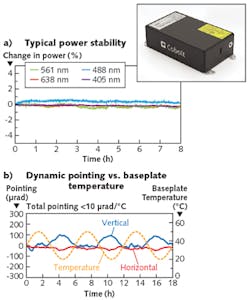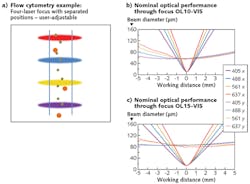Photonics Products: Lasers for Biosciences: Lasers for flow cytometry are small, solid, and reliable

In laser-based flow cytometry, biological cells (or sometimes other particles) in fluid are sent through a channel that is arranged so that the cells pass through one by one, allowing a laser, or often multiple lasers, to identify some aspect of the cells or particles. Often, cells in such a setup are labeled with fluorescent dyes. Flow cytometry can be used for science as well as the medical arena, and can enable devices that sort cells.
The technique is incredibly versatile, allowing everything from identifying pathogens, to sorting stem cells from non-stem cells, to diagnosing some forms of cancer. Because each type of detection task is different—for example, requiring a certain chosen fluorescent marker or markers—the required laser wavelengths span a wide range. While laser wavelengths are available in small modules suitable for medical instrumentation at wavelengths ranging from the near-ultraviolet (near-UV) to the near-infrared (near-IR), flow cytometry typically relies on light at visible wavelengths. UV flow cytometry is an area of active interest, with R&D being done on wavelengths into the deep-UV. Here, though, we concentrate on examples of workhorse light sources for flow cytometers: those operating in the visible spectrum.
Multiline lasers
Because flow cytometers often require more than one wavelength, multiline lasers are a natural for this purpose. Cobolt (Solna, Sweden) has provided the flow-cytometry market with standalone high-performance lasers over the visible spectrum for many years, notes Håkan Karlsson, the company’s CEO. “Originally, it was our DPSS laser technology with high powers of 532 nm and 561 nm which made Cobolt lasers attractive to the flow community, and in later years our diode-laser portfolio.” More recently following the market request for more compact, easy-to-use lasers, the company introduced a multiline laser—the Cobolt Skyra, Karlsson adds.
The Skyra combines up to four individual laser wavelengths, which are permanently aligned using a method that is patent-pending. “The idea was to be able to offer a single compact package that could be used like a single-line laser: that is, an easy-to-use, robust laser with no need for realignment,” Karlsson says. He also notes that the lasers are made via the company’s HTCure manufacturing method, which he says allows the light sources to meet the beam overlap, power stability, and noise specifications needed for flow cytometers (the HTCure includes matching coefficients of thermal expansion of components so that they are unaffected by the high-temperature baking process. In addition, Cobolt offers customized offset line focus optical designs, which are typically requested from the flow market.
The types of individual lasers available in the Skyra multiline laser include modulated laser diodes (MLDs) at 405, 445, 473, 488, 525, 633, 638, 647, and 660 nm wavelengths, and diode-pumped lasers (DPLs) at 532.1, 552.8, and 561.2 nm wavelengths. Optical output stability is better than ±1% over eight hours and pointing stability when cycled over a 30° range is better than ±100 µrad in both vertical and horizontal directions (see Fig. 1). A fiber-coupled option is also available.
“The trend to more compact systems in general in all analytical instrumentation, along with the understanding that by offering more wavelengths the instruments offer additional functionality, means that there is strong market demand for such a compact multiline laser,” Karlsson says.
Two trends
Daniel Callen, product line manager at Coherent (Santa Clara, CA), sees two trends in the area of laser-based flow cytometers used for cell sorting. First, he says, expanding the wavelength range supports multiparameter counting.
“Multiparameter methods maximize the data content in both clinical and research settings; that is, the ability to count a larger number of different cell types from the same sample,” Callen says. “Increasing the number of counting parameters can be achieved by using wavelength discrimination in both the detection and excitation channels. Specifically, multiparameter instruments measure fluorescence in multiple wavelength bins, and also correlate these signals as a function of several different laser wavelengths. To increase the number of parameters that are simultaneously profiled, instrument builders and users are looking to new laser wavelengths—particularly in the UV, but also in the near-IR and at key visible wavelengths.”
Callen explains that the wavelength flexibility of optically pumped semiconductor laser (OPSL) technology, alongside a growing range of available laser diodes, makes these technologies ideal to meet this demand for an expanded palette of wavelengths. At the same time, packaging OPSLs and diode technologies into a common, self-contained smart format such as the Coherent OBIS, has enabled new wavelengths to be added or replaced in a simple plug-and-play fashion.
The second trend mentioned by Callen is the increasing availability and use of integrated light engines with multiple addressable wavelengths.
“Although higher-end research instruments may, for the reasons above, use a large number of lasers with diverse wavelength options, there has been a convergence on a smaller set of standard wavelengths for clinical and related applications, he says. “Specifically, the majority of instruments still use just 405, 488, and 640 nm, with 561 nm sometimes added to the mix. This wavelength standardization has allowed laser manufacturers to take the plug-and-play concept to the next logical stage, with all the lasers and electronics provided in a single module that also includes beam shaping, steering, and focusing optics.”
An example of this approach is the OBIS CellX four-wavelength laser engine that includes lasers along with beam-delivery optics for typical flow cytometry applications, says John Abbott, director of laser measurement and control sales at Coherent. The instrument builder can select from different focus size options and then adjust the position and alignment of each beam by simple internal adjustments, matching the requirements of a particular cytometer design (see Fig. 2). By outsourcing the beam handling and laser integration, the instrument builder cuts development costs and shortens time to market while also minimizing performance risk. Additionally, Abbott says, integrated laser engines such as the CellX allow capital cost reduction by consolidating hardware and electronics, for instance, by shared thermal management and by using a single controller board to drive the lasers, with common power and input/output connectors.Pulsed as well as continuous-wave
“In addition to the usual research and clinical diagnostics applications,” Chui adds, “one application of flow cytometry that is a bit less known is gender/trait selection for animal husbandry, such as for cattle breeding. It’s an important commercial application that’s enabled by lasers.”
For More Information
Companies mentioned in this article include:
Cobolt
Solna, Sweden
Coherent
Santa Clara, CA
Spectra-Physics (MKS Instruments)
Santa Clara, CA
DISCLAIMER: While we try to include information from the broadest possible number of companies that manufacture the products featured in our Photonics Products series, because of limited word count as well as deadlines that cannot always be met by requested contributors, we cannot possibly include all companies and regret if your company is not included in our series.

John Wallace | Senior Technical Editor (1998-2022)
John Wallace was with Laser Focus World for nearly 25 years, retiring in late June 2022. He obtained a bachelor's degree in mechanical engineering and physics at Rutgers University and a master's in optical engineering at the University of Rochester. Before becoming an editor, John worked as an engineer at RCA, Exxon, Eastman Kodak, and GCA Corporation.
